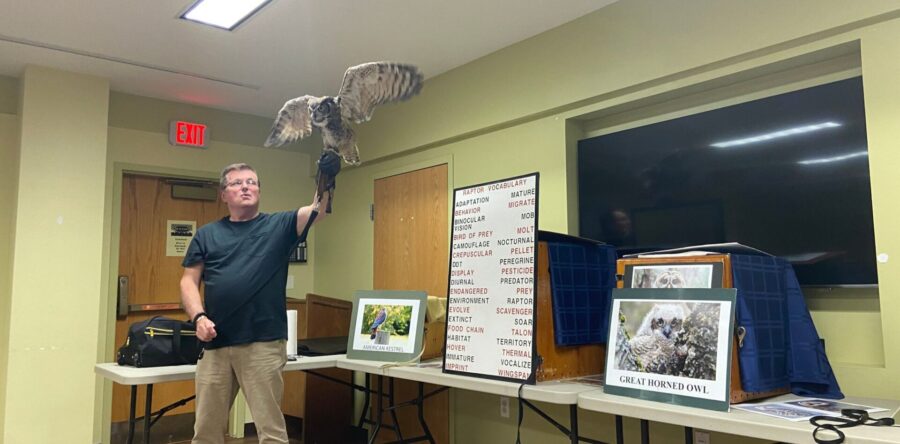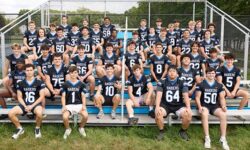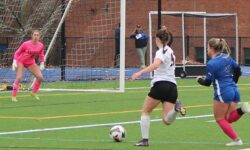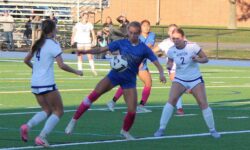By Avonlea Cummings
Hometown Weekly Reporter
On a summer morning, striking a nosedive breaking through the balmy air, and reaching speeds up to 200 miles per hour, a falcon hunts for its prey. As the sun begins to set, critters below search the grounds of a neighborhood hunts for scraps, and an owl prepares for a long night of activity. At dusk, an owl quietly swoops downs reaching for the little rodent it has kept an eye on, catching its prey for its first meal of the night.
These birds are wing masters of the sky and have called Dover – Sherborn their home for hundreds of years. Recently, on July 20th the Dover Town Library (DTL) hosted these magnificent creatures throughout the Wing Master’s: Birds of Prey presentation. Seats were overflowing with guests as they came to gaze and learn about the unique beauty these birds possess, and the features that make them such outstanding creatures.
Rob Park, one of the co-founders of the Wing Master’s rehabilitation and education program presented six of these common birds that we don’t often know are right outside our window. Park began his presentation by explaining the passion he has for saving these injured wing masters and sending them back out into the wild. Although less than ten percent of their patients are too injured to safely return to their natural habitats.
Throughout his presentation, Park brought out each of his unique visitors he brought with him to share with the audience. Beginning with an American Kestrel falcon, Park explained the hunting styles of the falcon pointing out the sounds of its wings. He mentioned the pointed shape of its wings was the inspiration by German engineers who made the first-ever airplane wings to come to a point.
Next, Park showed the Red-Tail Hawk an animal that we often see soaring circles in the sky. He explained to the audience the reasoning behind Red-Tailed Hawks’ movement patterns and the history behind them. He shared that Red-Tailed hawks live to be nine years old out in the wild and that his hawk is now in its thirties.
A Barred Owl was the next visitor to be shown by Park and the audience was on the edge of their seats. Interacting with the crowd, Park brought the Barred Owl down the middle of the aisle asking the important question of how much they thought the owl weighed. The children guess from seven to nine pounds in weight after learning it was the second-biggest owl. To their surprise, Park revealed that this fluffy friend only weighed to be one pound, and the on-goers were astonished.
Following the cute Barred Owl, was a new friend Park introduced, a real head-turner, the Great Horned Owl. Before noticing its swiveling head, Park explained how owls do not rotate their heads 360 degrees, in fact, they only turn their heads 180 degrees just like not other birds. The intriguing part of an owl turning its head that far is that it portrays the vision as if they do not have a neck whereas in other birds it is apparent.
Finally saving the best and possibly the cutest for last, Park brought out the tiniest visitor of the day. Roughly weighing one ounce, the Northern Saw-Whet Owl calls the exquisite neighborhoods of Dover it's home. Park relieved parents in the room that these little owls are mighty as they often are the best flying mouse traps to keep around the house.
All of the beautiful birds Park brought into the library were outstanding and many were entranced with the impressive abilities each animal possesses to hunt its prey. If you want to learn more about some of these awesome birds, be sure to check a book out at the Dover Town Library!






















